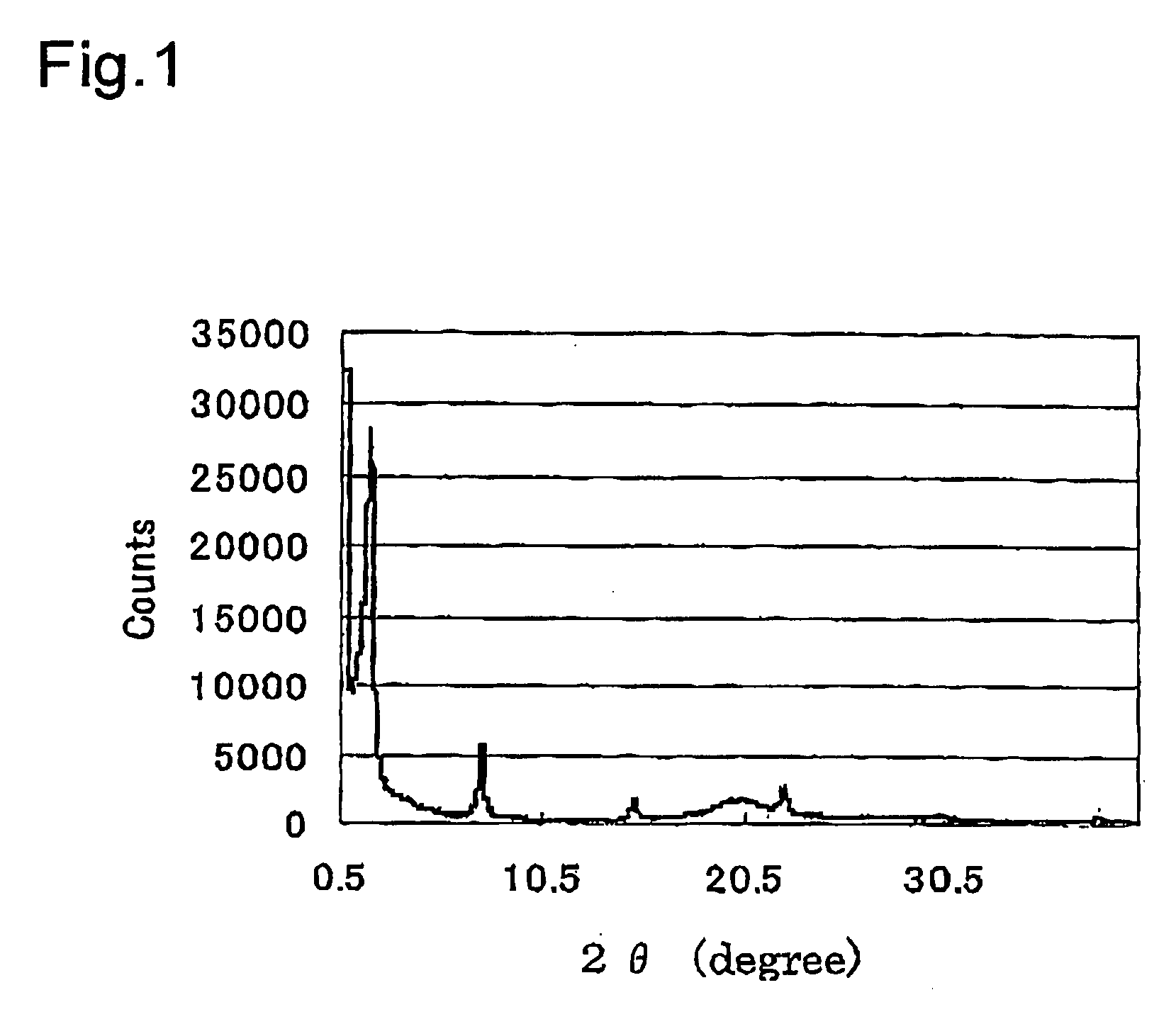Light energy conversion material
a technology of light energy and material, applied in the field of light energy conversion material, can solve the problems of insufficient amount of electron donor introduced in the pore, insufficient chemical energy conversion reaction, and inability to achieve the effect of increasing and improving the efficiency of light energy conversion
- Summary
- Abstract
- Description
- Claims
- Application Information
AI Technical Summary
Benefits of technology
Problems solved by technology
Method used
Image
Examples
synthesis example 1
Synthesis of Crystalline Powders of Silica Porous Material Modified by Biphenyl Group (BiPh-Hmm))
[0103]First, trimethyloctadecylammonium chloride (surfactant: 1.83 g, 5.26 mol) was dissolved in a mixed liquid of water (100 ml) and a 6 M aqueous solution of sodium hydroxide (10 g) to obtain a mixed solution. Then, 4,4′-bis(triethoxysilyl)biphenyl (2.00 g, 4.18 mol) was added dropwise into the obtained mixed solution while stirring at room temperature. Thereafter, the irradiation with ultrasonic waves for 20 minutes and the stirring were repeated to the mixed solution. Subsequently, the solution was stirred for 24 hours at room temperature to obtain a reaction solution. After that, the reaction solution was left at rest at a temperature condition of 98° C. for 48 hours. Then, the reaction solution was heated to obtain a silica porous material modified by a biphenyl group (BiPh-HMM) containing the surfactant. Subsequently, BiPh-HMM containing the surfactant was suspended in a mixed liq...
synthesis example 2
Synthesis of Thin Film of BiPh-HMM
[0106]First, a triblock copolymer P123 ((EO)20(PO)70(EO)20: surfactant: 0.40 g, 0.069 mmol) was dissolved in a mixed liquid of ethanol (3.0 g), water (0.18 g, 10 mmol) and 2 M HCl aqueous solution (5.0 μl, 0.010 mmol) to obtain a mixed solution. Then, 4,4′-bis(triethoxysilyl)biphenyl (0.598 g, 1.25 mmol) was added dropwise into the obtained mixed solution. Thereafter, the mixture was stirred at room temperature for 21 hours to obtain a reaction solution. Subsequently, ethanol (2.0 g) was added to the obtained reaction solution to obtain a biphenyl silica sol solution. Then, the sol solution was spin-coated (4000 rpm, 10 s) on a glass plate or a silica glass. Subsequently, the sol was dried at room temperature for one day to obtain a spin-coat thin film. The temperature of the obtained spin-coat thin film was increased from room temperature to 250° C. over 6 hours. Thereafter, the temperature was maintained at 250° C. for 2 hours. Then, the P123 (sur...
synthesis example 3
Synthesis of 4,4′-bipyridine Derivative
[N,N′-bis(3-(trimethoxysilanyl)propyl)-4,4′-bipyridinium diiodide])
[0108]First, 4,4′-bipyridyl (1.80 g, 11.0 mmol), and (3-iodopropyl)trimethoxysilane (7.02 g, 24.2 mmol) were dissolved in acetonitrile (25 ml) in an argon atmosphere to obtain a mixed solution. Then, the obtained mixed solution was stirred at 40° C. for 7 hours. Thereafter, the solution was stirred while heating at 70° C. for 18 hours. Furthermore, it was stirred while heating at 85° C. for 24 hours. Subsequently, the precipitate obtained in the above manner was washed with dichloromethane, and dried in vacuum to obtain 7.62 g of 4,4′-bipyridine derivative (N,N′-Bis(3-(trimethoxysilanyl)propyl)-4,4′-bipyridinium diiodide).
[0109]The structure of 4,4′-bipyridine derivative obtained in the above manner was recognized by 1H-NMR. The obtained results are shown below;
[0110]1H-NMR (500 MHz, D2O): δ 8.98 (d, 4H, J=6.7 Hz), 8.41 (d, 4H, J=6.7 Hz), 4.60 (t, 4H, J=7.3 Hz), 3.20 (s, 18H), 2...
PUM
| Property | Measurement | Unit |
|---|---|---|
| pore diameter | aaaaa | aaaaa |
| pore wall thickness | aaaaa | aaaaa |
| pH | aaaaa | aaaaa |
Abstract
Description
Claims
Application Information
 Login to View More
Login to View More - R&D
- Intellectual Property
- Life Sciences
- Materials
- Tech Scout
- Unparalleled Data Quality
- Higher Quality Content
- 60% Fewer Hallucinations
Browse by: Latest US Patents, China's latest patents, Technical Efficacy Thesaurus, Application Domain, Technology Topic, Popular Technical Reports.
© 2025 PatSnap. All rights reserved.Legal|Privacy policy|Modern Slavery Act Transparency Statement|Sitemap|About US| Contact US: help@patsnap.com



